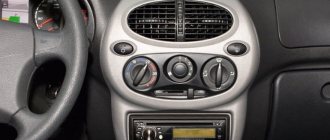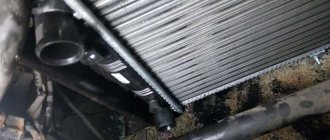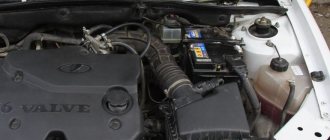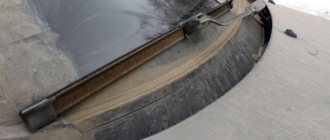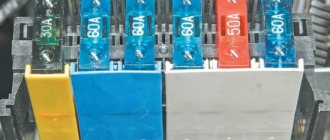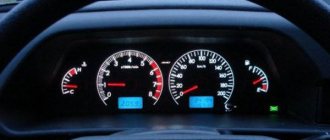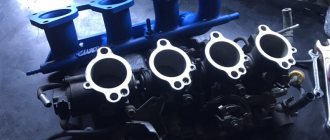Winter for a motorist results in a lot of unpleasant problems. What can we say about the increased danger associated with icy road surfaces, frozen door handles or a power unit that does not want to start. But even if you managed to sort out all the problems mentioned above, you still can’t go far in a car when the temperature inside the cabin is only a couple of degrees higher than outside, and even then only due to the warm air we exhale. A nightmare for any Lada Priora owner. Stove repair is a surefire diagnosis of a sudden problem, and we know how to deal with it.
A few words about the main thing. The principle of operation of the stove on the Lada Priora
Although the heating system on a Priora is considered a fairly reliable functional part of the car, it can also fail periodically. Worn bearings, flying electronics or a jammed damper - for an experienced motorist there are no unsolvable problems when it comes to servicing the stove unit on a Lada Priora, just as you shouldn’t soon have them either. It is best to understand the basics of repair by theoretically familiarizing yourself with the operating principle of a modern car heating system, and then only proceed with practical recommendations.
Today, they have not yet come up with a more ideal car heating system than one combined with an engine cooling circuit. The flow of coolant as the power unit warms up and during its normal operation is regulated by a thermostat. If its channels or valves are clogged or do not work, it is quite obvious that the liquid will not flow to the stove radiator in sufficient volume and the stove will not work.
Streams of warm air forcefully blow over the radiator of the Lada Priora stove using an electric fan. Depending on the temperature in the cabin, the fan speed can be adjusted by setting the electric current in the power circuit (a special control resistance is responsible for this). Additionally, the ratio of cold and hot air is regulated by a damper. Through the air filter, heat enters the car interior in such a simple way.
Next, the driver is free to choose through which channels, only for heating the windshield or all of them, the warm air will be distributed inside the car. A separate valve, also with an electric drive, is responsible for this on the Lada Priora. Its deformation or failure is a common problem with the stove on Lada Priora.
The last structural element that no Lada Priora stove can do without is an electronic control unit, the regulator of which is located on the front side of the dashboard of your iron horse. The temperature value set by the regulator is compared with the actual readings measured by the temperature sensor, after which the electronic unit sets control commands that regulate the operation of all of the above elements of the Lada Priora heating system:
- fan speed;
- air valve position.
No heating at idle
It is not for nothing that this issue has been submitted for separate consideration, since it worries many motorists and solving the problem can be much more difficult than one might expect. So, you have a Priora, the heater does not heat up at idle, although when the car is moving, the interior is heated in normal mode. Here you can also identify several possible reasons:
- Insufficient coolant level.
- Leaks that lead to a decrease in antifreeze levels.
- There is an air lock in the system.
If the first two problems can be easily diagnosed and eliminated, then with an air lock the situation is much more complicated. If you have ruled out the first two reasons and the Priora’s stove still does not heat up at idle, you need to eliminate the air lock. You must proceed as follows:
- We remove the screen from the engine.
- We lower the clamp, after which it is necessary to remove the heating tube for the throttle assembly. We choose any of the two.
- Unscrew the cap on the expansion tank. We place a clean rag on the neck and begin to blow into the expansion tank. The air supply should be carried out until coolant begins to pour out of the tube, which was previously removed.
- Immediately place the tube on the fitting and carefully tighten the clamp.
- Installing the screen.
What to do if the stove on the Lada Priora does not work. Practical advice for repairs
Removing an oven device from under the hood of a car is a very long and thankless process. The best place to start diagnosing the problem is by checking the condition of the thermostat that regulates the flow of coolant through your powertrain's operating circuits. The coolant passages leading to the furnace must be warm. If the main rubber hoses practically do not resist squeezing them with your hands, it is possible that the pump pump has also failed, as a result of which the necessary pressure of the fluid flows is not created.
A little trick also concerns the level of coolant in the system. If you fill it according to the minimum mark in the tank, then it takes slightly less time to warm it up and the coolant, which it is, begins to give off heat to the interior faster. Perhaps, if you are dissatisfied with the speed at which the Lada Priora stove reaches operating mode, this technique will be useful to you. Of course, in this case, you should not forget to regularly monitor the volume of coolant in the system.
What to do if the stove is constantly noisy during operation? In this case, most likely the problem is in the electric fan bearing. If you do not delay replacing it, the malfunction should not cause more discomfort than just extraneous noise. It is worth remembering that a faulty loose bearing will sooner or later lead to a fan wedge, which can result in much more serious problems.
It can also be considered a fairly standard procedure to check the condition of the fuse that protects the power electrical lines of the furnace on the Lada Priora. It is marked F9 and has a rating of 25 A. If the fuse blows with enviable regularity, in no case should you take the path of increasing its rating. You should check the electrical circuits of the furnace and the insulation condition of the fan windings with a multimeter. Perhaps, due to a turn short circuit that has arisen in it, the power circuit is overloaded.
If the stove constantly blows cold air, it is most likely the fault of the valve that controls the ratio of hot and cold air flows into the interior of your car. If the air flow is weak and frankly unsatisfactory, check the condition of the air filter. Oddly enough, motorists very often forget about the need to regularly replace it, as a result of which, with the onset of the frost season, they are literally caught by surprise by the cold.
Heater radiator clogged
When the heater radiator is clogged, the circulation of coolant through it becomes much worse, which leads to insufficient heat exchange. A clogged radiator occurs as a result of neglecting to replace the coolant for a long time.
Checking for a clogged radiator can be done by touching the pipes supplying coolant to it; they should both be hot, but if one of them is hot and the other is cold, then most likely the radiator is clogged. The check should be carried out with the heater fan turned off.
This condition is met if the air flow from the air ducts is of sufficient strength, but cold. If the flow is weak but hot, then most likely it is necessary to replace the cabin filter.
conclusions
At this point, we can consider the problems of the furnace device on your car to be fairly fully resolved. Almost any motorist who has studied the principle of its operation can repair the stove on a Lada Priora. In the future, the maintenance process consists of sequential diagnostics of its structural parts according to the above diagram. Most faults, such as cold air flows, insufficient heating and others, have a very clear diagnosis, which makes it quite easy to localize and fix the problem.
Today, a car is no longer an element of luxury; it is now a means of transportation and transportation of goods. When choosing a car, a car enthusiast focuses on:
- car price;
- the cost of upcoming repairs.
The most common model on the Russian car market is the Lada Priora. A number of problems arise with it due to the rapid wear of parts. Let's look at the issue of repairing the stove on Priora.
Dependence of the functioning of the stove in Priora on the engine cooling system
The main problem why the stove does not work on a Priora is a malfunction in the engine cooling system. Therefore, you should start looking for other damage after checking the engine cooling device:
- start the inspection from the liquid level of the expansion tank. The norm is considered to be a level between o and “maximum”. If you have to constantly add antifreeze to the reservoir, there is a leak somewhere. Immediately check all pipes for damage, and also see if the clamps are tightened well. Many drivers resort to a little trick so that warm air begins to blow into the cabin faster, deliberately keeping the coolant level at a minimum. The less it is, the more it heats up;
- the second stage is checking the fluid circulation in the cooling system. If the circulation is weak or non-existent, then the problem is in the pump. It may have stopped working and need to be replaced. Also, the cause may be a clog in the cooling system, and it needs to be cleaned;
- The next test step is to examine the thermostat. You need to warm up the engine to 75° C and touch the upper radiator pipe. If it remains cold, the thermostat is broken and needs to be replaced;
- It happens that the stove works, but cold air blows. In this case, the problem is the presence of air in the cooling system itself; it must be removed.
If everything is in order with the cooling, you can begin diagnosing the unit itself on the Priora.
Failure of the expansion tank cap
The expansion cap is a plug that prevents splashing of coolant in the engine compartment, but this is not its only task. The lid has a built-in valve in its design that relieves excess pressure and allows the required amount of air into the system so that vacuum and vacuum are not created in it. If the cap valve is faulty, then in cold weather a vacuum may be created in the cooling system, which will prevent good circulation through the heater radiator, and this will lead to insufficient heating of the radiator.
When unscrewing the plug, it is necessary to check its external condition; there should be no rust or traces of oxide on it. If the valve becomes stuck, the cover must be replaced.
The main problems with the heating system on Priora
Why doesn’t the stove heat up if everything is fine with the cooling system? First, it’s worth understanding how exactly the stove in a car works.
The temperature sensor in the cabin receives a signal from the heater control unit. Then the controller begins to compare the cabin temperature with the one set on the sensor by the driver. If there is a difference, the controller sends a signal to the heater gear motor located under the hood, and it, in turn, controls the operation of the damper and, depending on the signal, will open or close the air supply from the radiator.
If, regardless of whether the air regulator switches or not, only cold or hot air continues to blow into the cabin, it means that the control flaps are stuck in one position. In 17% of cases this is a breakdown of the heater in the car. There may be several reasons:
- The temperature sensor located on the ceiling in the cabin is broken.
- The damper micromotor is faulty, the gear teeth are worn out or the resistor layer is worn out.
- Clogged cabin filter.
- A complete lack of flow indicates a broken heater fuse.
The next part to check if all of the above is ok is the fan. It may need to be replaced. If the stove makes humming or whistling sounds when operating, this is also a sign of a fan malfunction.
The next point to check is the heating resistor; its main function is to switch fan speeds.
If everything is fine with the dampers, but cold air continues to blow into the cabin, the radiator may be clogged. When the check of each described part is completed, but the problem remains, you should examine the controller itself for controlling the operation of the stove.
But before you buy a new device, check the functionality of the old one. Just replace it with another controller that you can borrow from a friend. Perhaps the problem with the poor performance of the stove is something else.
Recommendations
Comments 42
He’ll overlook the antifreeze) so the first reason is the green thing... If necessary, I’ll write about it a little later
Thanks, I'll wait
And so, if the gearmotor is in working condition and does not jam, then the problem is with the Additional heater resistor. It is when this thing fails that hot air stops flowing into the cabin. On my Priora, the gear motor broke at one time, the characteristic sound of its operation was not heard... after replacement, everything was normal. The guy on the luxury Prior also had a problem with hot air, but he got around it by adding antifreeze, the pipe was leaking. Another friend had this problem, and it was his resistor that burned out. So first test the gear motor, if that’s not the problem, then change the resistor. They are located close to each other. Here is a link to the structure of the Priora stove, which was the first one I came across. Number 6 is that ill-fated green thing in the color picture)))) club-lada.rf/priora-remont/220-pechka-priora.html
Thanks a lot! I decided not to climb myself, I’ll go to the station.
The first reason is to check the antifreeze level. Next comes the damper gear motor, if when you turn the knob that switches hot cold air you can’t hear it working, then it’s it. If it switches, then the problem is (I don’t remember exactly what this green thing under the hood in the stove body is called), but it is this thing that is responsible for the hot air.
look at the pump, it's probably leaking brains
Perhaps it was the pump I had like this, the impeller fell off and turned, it was also blowing cold, I dismantled the stove, changed the gear motor, radiator, and then as it got warmer the car began to warm up, I changed the pump and that’s it Tashkent
I'm not inclined towards the pump. I’ve been driving like this for a year now, I think it would prove itself in the summer...
Class! Thank you! Maybe I'll change it today!))))
Option 1 - the problem is in the gear motor gear, it does not turn until it warms up. Option 2 - the problem is in the temperature sensor in the ceiling, it is this that regulates the position of the heater damper, depending on the temperature in the cabin and the desired temperature on the regulator. If you turn off this sensor, then the position of the damper will correspond to the position on the regulator.
It doesn't need to warm up to turn over. It is already lubricated with lubricant in a sealed housing. There’s nothing special for her to warm up there. It won't turn if its teeth break. Desynchronization of the position of the damper and the control knob occurs precisely because the sensor sends a signal to an already obviously broken regulator. A gear with broken teeth jumps over normal ones. Over time, the next teeth will break, and as a result an unpredictable wedge
Are you treating from photographs?
necessary, not necessary - the fact is the fact that the damper turns only when the engine is warmed up. What prevents the gear motor from rotating until it warms up? and it rotates... not immediately, but much later - which means warming up is important. and if it had been teeth, it would have turned right away. without waiting for it to warm up. A gear with broken teeth jumps over normal ones - complete nonsense. disassemble the gear motor at least once. the teeth there do not break, but the edges are eaten away and that is why a wedge appears.
There is no desynchronization between the handle and the sensor; it contains the principle of a constantly adjusting heater damper, based on the readings of the interior temperature sensor. Let’s say we want 20+ and we have 12, then the gear motor will open the damper as much as possible, then as the interior warms up, as it warms up it lowers it to a position in which the flow of hot air will maintain 20+ in the cabin.
not from the photo, but from experience, I myself changed 3 of these gearboxes; all of them had 3 broken teeth on the selector gear, I took them apart and saw how they were arranged inside, the teeth were broken, not ground off. The gearbox does not need heating to operate. The gearbox starts moving as soon as you start the car - IMMEDIATELY look for a new position from the one in which it remained before turning off, taking into account the changed weather realities, as shown by the sensor in the cabin. It moves immediately, without warming up. And if you left it at 20+ and it’s -10 outside in the morning, then in order to heat the solon again to 20+, the damper will start from a different position, immediately setting it to 20+ and not the maximum, this is not required of it. And it will begin to move slowly after the interior has warmed up to 20+, reducing the warm air, thereby maintaining 20+. And it is during the initial start-up that the teeth in the gearbox break - for what reason - that’s another matter, wear there or a high starting current or something else. When 1 tooth is broken, it’s not scary, but when 2 or more are broken, it begins to jump or slip, causing a mismatch between the position of the damper and the control knob, and when, for example, you want heat, the lack of teeth does not allow you to move the damper to this position. So disassemble the gearbox yourself, just break 2-3 teeth, rotate the broken gear against the whole one and see how a discrepancy arises. As a result, the broken gear will take such a position that neither the manual control nor the sensor will move it.
Other heating system faults
The Priora has a heating system installed. It seems to be a reputable Japanese company, but for some reason problems with its climate control system arise more often than others. What this is connected with is unclear. For example, in the hot summer, the fan always has to be turned on at maximum speed in order to have at least some cooling effect.
You understand that this mode does not contribute to long-term operation. Another common problem is a malfunction of the operating modes for switching airflow from feet to glass or face. This is usually due to a breakdown of the gear motor or stove control controller.
Another snag is that the stove only works at 4th speed. There are also several reasons for this. There may be a problem with the resistor or the heater control unit.
The Lada Priora car enjoys the well-deserved love and respect of our compatriots. Good value for money, availability of spare parts and excellent maintainability make it the leader of the domestic automotive market. However, being the result of a Russian design, this car also has some disadvantages.
As you know, Priora is a deep restyling of the previous model - the 2110th. Therefore, most components and assemblies moved from the “ten”, including the design of the heating and ventilation systems for the interior. Most of the main parts of this system are “decimals”.
Therefore, such unification is very helpful during repairs. Unfortunately, this feature backfires when malfunctions occur. There are quite frequent cases when the stove on a Priora does not work. The situations are different. In one case there may be problems with the fan, in another - with the dampers, etc.
Preparatory stage
Troubleshooting the heater should begin provided that the power unit and engine cooling system are in order to eliminate their influence. To do this, you need to make sure that the antifreeze is poured in the proper amount, the engine is in good condition and is functioning normally. And after that, find out why the stove on the Priora does not work. First, check the coolant level in the expansion tank. Next, you need to start the engine and warm it up to operating temperature. After this, you need to check the serviceability of the thermostat - feel the thick hoses that go from it to the car radiator.
The top one should gradually become hot. If the rubber hose is still cold, the thermostat is faulty. In this case, you can continue working only after replacing this element. Fortunately, its cost is low.
Another reason why the engine may not warm up to operating temperature is a leaky expansion tank cap. It should keep excess pressure in the system. Often, simply replacing this cover can completely eliminate the problem.
On the Priora, unlike the Tens, the cooling system is organized differently. And the formation of an air lock there is practically excluded. It can occur when the system is leaking or when antifreeze is poured into a completely empty expansion tank. This can be fixed quite simply. You need to drive your front wheels up some hill in a warm car and vigorously apply the gas in place. The expansion tank cap should be removed.
Causes of cold air from the stove
There are quite a few reasons why the heater can blow cold air, and to determine the specific cause, you will have to tinker a little with the car in order to correctly diagnose the breakdown.
List of reasons:
- The heater radiator is clogged;
- The damper position gearmotor is broken;
- Thermostat is faulty;
- Insufficient amount of coolant;
- The expansion tank cap is faulty;
Let's look at each of the reasons in more detail and start with the most primitive ones.
Heater radiator malfunctions
Another reason why the deflectors in a Lada Priora car do not work may be the accumulation of dirt in the heat exchanger. When the cooling system operates, deposits accumulate in the engine block itself over time, which are then spread throughout the entire system, including into the heater radiator. These deposits prevent it from working effectively. The system will heat the air worse. In this case, the heater radiator can be replaced entirely. It is removed from the engine side. Before starting work, be sure to drain the antifreeze from the cooling system. Then dismantle the windshield wiper arms, the frill trim and move aside part of the soundproofing shield. After this, disassemble the stove body, disconnect the wires, remove the fan motor along with the impeller and remove the heat exchanger, disconnecting the supply hoses from it.
Problems with the damper gear motor or fan motor
A common malfunction on a Lada Priora car is that the heater does not work. No air blowing at all.
First, you should make sure that the heater motor is working - at least cold air should be blowing from the deflectors. If not, then you need to check the integrity of fuse F9.
If it is intact, it means the stove fan is not working. "Priora" is equipped with a "ten" fan. Therefore, removing it exactly repeats the procedure on the “ten”. In some cases, the fan does not spin because leaves or other foreign objects have gotten between the impeller and its housing, which can block rotation. In this case, you can hear a characteristic hum.
Cold air can also come out of the deflectors because the gear motor that controls the damper that blocks the flow of hot air is not working. It is also accessible from under the hood.
Often the cause of gearmotor failure is oxidation of conductive contacts. They need to be cleaned with sandpaper by disassembling the body. You should also pay attention to the strength of the air flow. If even at maximum speed the air is blowing weakly, it is possible that the problem is clogged. It is located under the hood in the heater housing and creates additional interference.
The stove does not turn on
In a situation where the Priora stove does not turn on, there may be two explanations - a blown fuse, a blown fan motor, a breakdown of the controller, or oxidation of the contacts in the connectors.
After checking the fuse, take the following steps:
- Open the hood and on the left side (looking at the windshield) remove the rubber seal at the top left.
- Remove the four screws to remove the trim.
- Find the heater connector somewhere near the third mount.
- Turn on the ignition.
- Try to press the connector and pay attention to whether the stove starts working or not.
Damage to the connector is a real problem on the Priora, so do not rush to immediately change the control unit or other elements before checking the fuse and the quality of the contact connection.
Additional resistance fault
There are often situations when the heater switch on a Priora does not work - the motor operates only at fourth speed or only at first. The reason here may be additional resistance, which slows down the rotation speed of the stove fan.
This resistance is a block of resistors (the fourth speed is direct, without deceleration). It is located in the heater housing on the left side and is secured with two screws. This resistance is also unified with many domestic models (2110, Kalina, Chevrolet Niva).
Malfunctions of the heater control unit
The operation of the heating system is completely dependent on the heater. It distributes air flows, the intensity of airflow to different zones of the cabin and the temperature regime. If it fails, the stove naturally stops working.
There may be malfunctions of the switches (“twisters”). The malfunction of the control unit should be checked last, since this unit is electronic and can rarely be repaired. Therefore, to check it, it is advisable to temporarily replace it with one that is known to work, borrowing it from a friend or in a store with a deposit.
Features of the heater in a Priora with air conditioning
A common reason why the stove (Priora with air conditioning) does not work is the failure of the speed control unit (RFV), which is located on the heater housing under the hood. It regulates the intensity of the fan motor. If it fails, the stove stops functioning altogether or operates only at fourth speed.
The cause of the malfunction is often prolonged operation of the heater in recirculation mode (with the air damper closed) and, as a consequence, its overheating. Therefore, its performance should also be checked.
We carry out comprehensive diagnostics
Removing a faulty heater from a Lada Priora is not so easy. Even experienced motorists cannot cope with this task quickly. To avoid doing such a large amount of work in vain, it is better to first diagnose the heating system. You must proceed as follows:
- We probe the channels through which the coolant flows to the heater. They should be warm when the stove is on. In addition, when pressing on the main rubber hoses, resistance should be felt. If resistance is not felt, the pump pump may be faulty. This mechanism is responsible for creating the pressure of fluid flows necessary for normal operation of the heater.
- A little secret that may be useful to Lada Priora owners: does the stove blow cold air for a long time and does not warm up as quickly as we would like? Then you can try filling coolant to the bottom mark in the tank. In this case, the liquid will warm up faster. If you practice this method, you will need to constantly check the coolant level.
- If a running heater is a source of noise, then we can talk about a problem in the bearing, which is located on the electric fan. This situation cannot be ignored, since in the future the fan may jam and repairs will take place on a much larger scale.
- Is the stove not working? Perhaps the problem is hidden in fuse F9 with a rating of 25 A. Its function is to protect the power electrical lines of the heater. A blown fuse must be replaced. If such a situation occurs with enviable consistency, then it is necessary to check all electrical circuits of the heater, the insulation of the windings on the fan and the presence of an overload in the power circuit.
Cooling system or motor?
Before you begin troubleshooting the heating of the furnace, it is necessary to eliminate the impact of breakdowns of the cooling system and engine. Only then can you begin to find out why on Priora. To do this, we check the antifreeze level and engine operation. First step: look into the expansion tank and determine the coolant level. Then turn on the engine and warm it up for a while. This will allow you to determine whether the thermostat is functioning correctly. Just touch the thick pipes leading to the radiator.
If you find that the top pipe is hot, this indicates that the device is functioning normally. A cold pipe is a sign that the thermostat is not working properly and you will need to replace it. This part is inexpensive, so replacement will be easy. A loose expansion tank cap is another reason why the engine remains cold. Because of this, the Priora stove switch may not work. Just replace this part.
The cooling system of Lada Priora is slightly different from the tenth model; it practically does not create an air lock. It can be caused by incomplete system insulation or antifreeze poured into an empty expansion tank. Solving the problem is not difficult. Remove the reservoir cap, stand on a hill with your front wheels and accelerate.
Thermostat is faulty
If the thermostat malfunctions, the car will take quite a long time to warm up in the cold season. This is due to the fact that the coolant will circulate in a large circle through the cooling radiator and it will be much more difficult for the engine to warm up to operating temperature. As you know, the lower the temperature of the engine and coolant, the colder it blows from the stove.
You can check the thermostat by starting the car and letting it run for 10 minutes, and then touch the lower radiator hose, it should be cold until the car warms up to operating temperature. If the lower radiator hose warms up evenly with the upper one, this means that the thermostat is stuck in the open position and needs to be replaced.
Repairing fan and radiator
Often the heater regulator on a Priora does not work due to the fact that a large amount of dust or other small dirt particles has entered the heat exchanger. Over time, contaminants get inside heating devices. This cannot but affect the performance of the entire system. Air masses do not warm up well. You may note that the oven only works in position 4. In case of contamination, you can simply. You need to remove the device from the power unit side. Do not forget to first drain the antifreeze from the cooling system, disconnect the windshield wipers and wires, dismantle the fan completely and remove the entire radiator by removing the pipes leading to it.
There is not only the problem that the Priora stove operates only at maximum, but also the complete absence of air jets from the heating system. The first step is to make sure that the radiator is working in principle. Place your hand and note whether any streams of air are blown out. Even cold air masses indicate that the system is operating. Otherwise, there is a possibility of fuse failure.
If the fuse stops, it means the furnace fan is broken. One possible reason for the fan not spinning could be small leaves or other small objects that have gotten into the fan. This will be confirmed by a hum. If necessary, you can remove the fan on the Lada Priora using the same procedure as on the tenth model. Replacing the fan will solve the problem.
On Lada Priora, the damper may not work, which will prevent hot air jets from entering the cabin. You can get to the gearmotor through the hood. If the problem is not with the damper, then most likely the stove is not working due to the contacts being oxidized. Simply clean them with sandpaper.
Is it all about the filter?
Often, replacing the filter can help solve the problem of weak air mass flows - when dirty, it becomes an obstacle to the passage of warm air. And then, even at high speed, the air flow can be too weak. You can also repair the heater rheostat (Priora with air conditioning) yourself. It is enough to replace the thermal fuse. This is precisely what a clogged filter affects. The thermal fuse overheats and fails; it only works at the maximum position.
If the Priora stove only works in position 4, then this may indicate that the rheostat has burned out. The same problem can lead to the heating system operating exclusively in the first position. Additional resistance causes the stove to work worse and slower. You will note that the Priora stove switch does not work.
Many passenger cars of the domestic automobile industry have a similar resistor block to the Lada Priora. You can get to the rheostat of the Priora stove through the housing on the left. You need to unscrew two screws to get to this block.
Temperature sensor and control unit
Switching may be difficult due to malfunctions in the temperature sensor located inside the car. You can find it in the lampshade on the ceiling of the cabin. The regulator changes the mode, transmitting data on the air temperature in the cabin to the gearbox. Depending on the temperature, the damper closes or opens. The serviceability of this element of the heating system affects the correct operation of the stove.
Heating a car depends on the operation of the entire heating control unit. It is in it that the distribution of air jets occurs, the strength of the direction of air flows to one or another part of the cabin is determined, and the temperature value is determined. It is better if the reason for the failure is the resistance of the Priora stove, since it is difficult to repair the unit. To make sure that the reason for the incorrect heating operation is in the unit, you need to remove your unit and replace it with one that is in working condition.
In cars with air conditioning, the speed controller often fails. In the event of a breakdown, the heating system does not work or turns on only in the maximum position. Such a breakdown occurs when the oven operates for a long time with the damper in the closed position. This is where overheating occurs.
Finding the cause of a malfunction is not difficult if you understand the principles of operation of parts and assemblies. The correct sequence of work will allow you to eliminate the breakdown in a short time.
Heating system elements (stoves)
The fact that the Priora stove is 95% similar to the “ten” can be seen by the catalog numbers:
- Heater assembly (2170-8101012 or 2111-8101012-10).
- Air flow distribution gearmotor (2170-8127100). Distributes air flow to the feet/face/windshield. Located inside the dashboard.
- Interior air temperature sensor (11186-8128050). Located on the ceiling.
- Heater control controller (HCU) or stove control unit (21703-8128020). The block on which the driver sets the operating parameters of the stove. Located on the panel.
- Additional resistor or additional resistor (2123-8118022). Determines the rotation speed of the stove fan. Secured in the engine compartment.
- Electric heater fan (2111-8118020). Located under the hood.
- Heater damper motor reducer (2110-8127200). Distributes air flows into the cabin (outside/heater radiator). Inside the heater assembly.
- Air filter (2110-8122020).
- Heater radiator (2110-8101060). Located inside the heater.
A malfunction of one of these elements causes problems in the operation of the stove.
